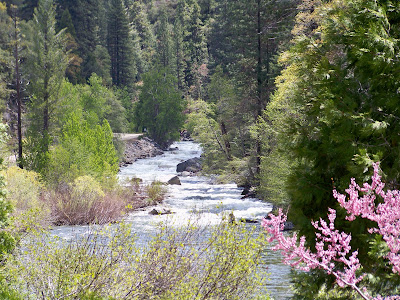Here I am waiving to my adoring fans, that would be me, while at the entrance to Yosemite National Park.
Yosemite National Park, one of the first wilderness parks in the United States, is best known for its waterfalls, but within its nearly 1,200 square miles, you can find deep valleys, grand meadows, ancient giant sequoias, a vast wilderness area, and much more.

Yosemite National Park, one of the first wilderness parks in the United States, is best known for its waterfalls, but within its nearly 1,200 square miles, you can find deep valleys, grand meadows, ancient giant sequoias, a vast wilderness area, and much more.

A photo of us at the Mariposa Grove at Yosemite which contains hundreds of sequoias. There are two other smaller groves of sequoias here at Yosemite - the Tuolumne and Merced which each hold a dozen trees.
Another uprooted sequoia tree. Looks a little like Kathy's hair on a bad hair day.
The famous clothespin tree in the Mariposa Grove. This tree is hundreds of years old and has survived numerous forest fires. The fires have systematically burned out the interior portions of the tree without killing it.
Here are some friends we met along the route. Looks like I got the wrong side of them.
Heading to Yosemite Valley, you need to go through a tunnel, known as Wawona tunnel. Out from Wawona tunnel, you'll enter Yosemite Valley. The view from the point outside of the tunnel is known as "tunnel view". That point is one of the most favorite picture taking points in the park.
This is the breathtaking photo of Yosemite Valley from the other side of the tunnel. It looks like a priceless painting but it's Yosemite in all its glory. You can see Bridalveil Falls below Cathedral Rocks along with El Capitan, large granite cliff on left and Half Dome way in the back center of the photo.
Here's a close up photo of Bridalveil Falls. It falls some 617 feet and flows year round. The Ahwahneechee tribe believed that Bridalveil Fall was home to a vengeful spirit named Pohono which guarded the entrance to the valley, and that those leaving the valley must not look directly into the waterfall lest they be cursed. They also believed that inhaling the mist of Bridalveil Fall would improve one's chances of marriage
El Capitan is a 3000-foot vertical rock formation in Yosemite and is a favorite for experienced rock climbers. Many people visiting the park just set and watch the climbers for hours. Once considered impossible to climb, El Capitan is now the standard for big-wall climbing
Yosemite Falls is the highest measured waterfall in North America. The total 2,425 feet from the top of the upper falls to the base of the lower falls qualifies Yosemite Falls as the sixth highest waterfall in the world. During our visit the falls was at its peak.
You can see the plentiful water flow in this short video of Yosemite falls.

















































